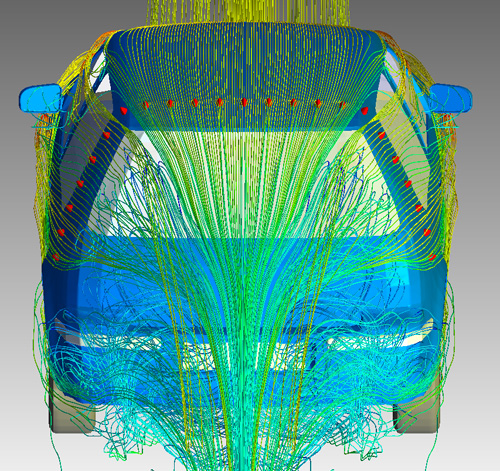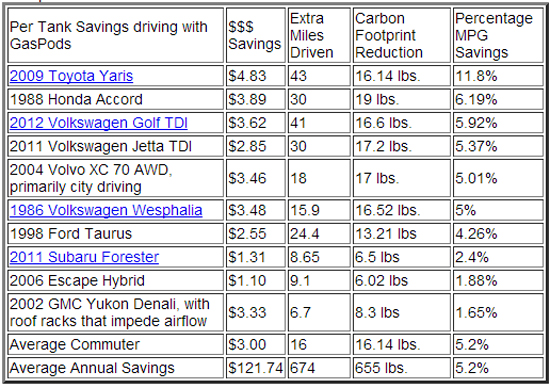GasPods – Saving Fuel with Roof Attachments
Tim Esterdahl | Mar 27, 2013 | Comments 22
We are always on the lookout for innovative ways to save fuel and help our readers get more MPG. Here is yet another way to save fuel albeit with some rather odd looking roof attachments.
 These GasPods are designed to enhance the airflow around the vehicle resulting in a reduction in drag much like the new aerofins on the 2014 Toyota Tundra. The GasPods makers claim that:
These GasPods are designed to enhance the airflow around the vehicle resulting in a reduction in drag much like the new aerofins on the 2014 Toyota Tundra. The GasPods makers claim that:
Computational aerodynamic performance modeling analysis (simulated wind tunnel testing) conducted by the world’s largest independent Computational Fluid Dynamic (CFD) focused provider of engineering simulation software, support and services, concluded that a kit of 10 GasPods placed along the rear roof of a vehicle traveling 35 and 65 mph expanded, organized, and enhanced the airflow to result in a reduction of the vehicle’s drag coefficient by around five percent (5%).

Streamlines from Computational Fluid Analysis – Simulated Wind Tunnel Tests.
Our editor and engineer guru Jason Lancaster says, “I think the science is sound, but it seems a little unbelievable. If it were this easy, I’d guess Detroit would have tried it by now…but who knows.”
These GasPods run from $79 to $125 for a set depending on how you want to install them and if you decide to match your vehicle color.

This chart shows some real-world testers results. Some of the results are significant while others not so much.
It does seem really interesting that these GasPods are so similar to the new aerofin ideas that Toyota is employing. This idea could be a part of the larger fuel savings goal in full-size pickups. While we realize that not everyone that drives a pickup cares about MPG, there are many owners who do. By using this idea and others like the new eVOLVE tires, significant fuel savings could finally be realized. The problem is that nobody really knows for sure since there are so many different, new ideas that have yet to be combined into a real-world test.
What do you think of these new GasPod innovations? Could simply adding these to your truck improve your MPG?
Related Posts:
Filed Under: Auto News


Balderdash! No way those little ‘pods’ are reducing fuel consumption that much by a proposed alteration in air flow over the car. Automakers are increasing body cladding, reducing weight, using 6 and 8 speed transmissions, and turbocharging small engines to reduce fuel consumption. I seriously doubt the best and brightest in this country failed to miss this one simple modification to increase fuel milage by 3-10%. I agree with Jason on this one, “If it were this easy Detroit would be doing it already.” Just another snake oil type product like the Tornado Fuel Saver.
“Balderdash!” LOL. Thanks for the chuckle, love it when people use that word correctly. Sad that it has left our everyday vocabulary.
-Tim
Did someone already say “gimmic”?
Umm… I believe you are the first on this site. 🙂
-Tim
They will save gas ………… FROM REDUCING THE WEIGHT OF YOUR WALLET!!
LOL!
-Tim
Eww…
Really, you don’t find them sexy?! 🙂
-Tim
This idea was merely lifted from the aviation industry. Both light aircraft, and heavy jets, have employed the use of vortex generators.
VG’s are little wedge shaped devices that alter the airflow over a surface. They work on aircraft to make the wing more efficient and lowering the stall speed.
Don’t take my word for it. Next time you’re riding on a 737, look out the window at the wing and engine cowling. You’ll see some little “V” shaped protrusions.
I can’t attest to the kind of numbers the company is claiming, but VG’s do work on airplanes. By improving the efficiency of the wing, they save fuel.
They are a very popular part of STOL kits (short take off and landing kits)for aircraft.
I would be curious to see some third party testing in the automotive application to see what kind of improvement they offer.
I remember getting the same line about adding a tonneau cover on my pickup. I didn’t notice a real gain in mpg.
“I remember getting the same line about adding a tonneau cover on my pickup. I didn’t notice a real gain in mpg.”
Touche
Here’s an idustry first in saving mpg’s Go 55 vice 70mph.
As Sammy said…”I can’t drive 55…”
LOL – 100% correct. Dropping from 75mph to 55mph makes a HUGE difference, as the amount of aerodynamic drag drops dramatically.
Another item for the JCW catalog.
Just goes to show, you can sell people anything. I’m going to put them on my trucks so I get 35MPG. EcoBoost turbo charged motors are waste of money when all you need are these things.
I don’t need a new truck.
I’m thinking about putting these “gas pods” on my bicycle so I don’t have to peddle as hard…LOL
We all missed the obvious. The pods came out of a Crown Royal “stash bag” it appears. By emptying the stash first, you will feel like you’re sailing along saving fuel.
You just alternate using the bag for your stash and your pods and life will be grand!
LOL! I thought that was what she was holding yet I didn’t want to jump to conclusions.
-Tim
I didn’t want to jump either since I’m not sure if that use is still popular. I was thinking in 70s mode for a minute there.
Similar to Airtabs which makes vortex generators for big rigs and rv’s.
Art,
Do you know if these Airtabs increase MPG in big rigs and RVs? And/or can you explain more about them?
-Tim
The air tabs for trucks and RVs are just like the vortex generators for aircraft that I mentioned earlier.
The physics is sound. Whether or not that translates in to real world fuel savings in the automotive industry I can’t say.
I know they improve aircraft performance, but it’s for a slightly different reason. (improving wing efficiency)
Aeronautical engineers are crafty. They discovered the benefit of “winglets” years ago, and they are nearly standard now on heavy aircraft. Fluid mechanics can be a beautiful thing.
Maybe one day these will catch on, and we’ll all have bumps on our cars? I’m not so sure about trucks. Maybe we’ll need tonneau covers with bumbs? Yea….that’s the ticket.
This discussion reminds me of golf balls. The first ones were round and it was thought that the old “nicked” up balls were junk UNTIL they discovered the ones with nicks flew straighter and further. Physics is a funny thing. 🙂
-Tim